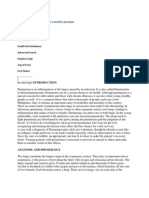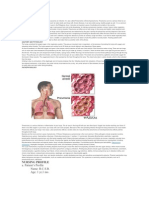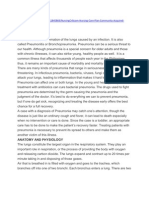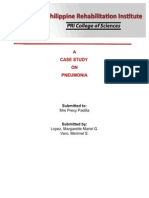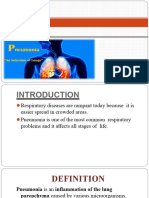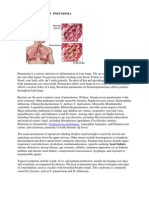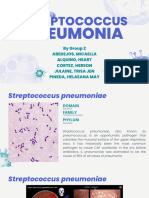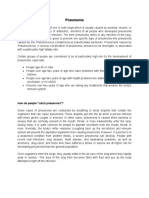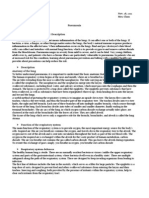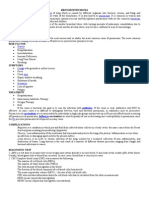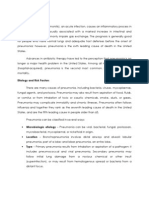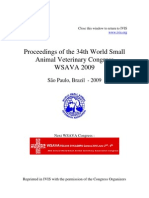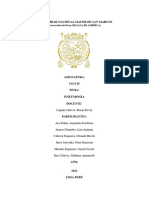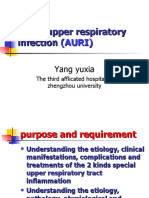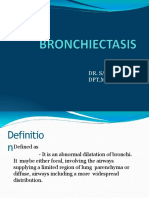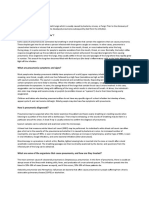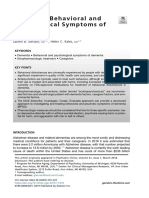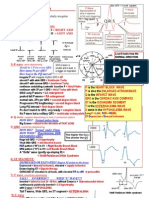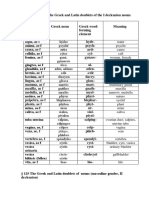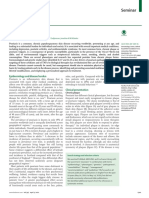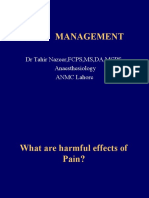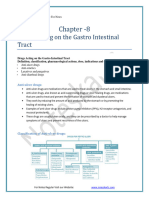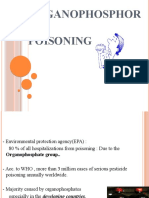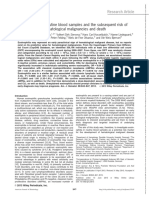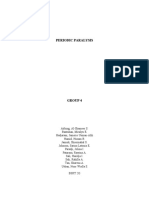0 ratings0% found this document useful (0 votes)
62 viewsInflammation of The Lungs
Inflammation of The Lungs
Uploaded by
Nikka MariePneumonia is an inflammation of the lungs caused by infection that can range from mild to life-threatening. It affects the air sacs in the lungs, filling them with fluid and pus and making it difficult to get oxygen into the blood. Pneumonia is most commonly caused by bacteria or viruses and can be treated with antibiotics if bacterial or antiviral medications if viral. For mild cases, treatment is usually at home with oral antibiotics and rest, while more severe cases may require hospitalization, intravenous antibiotics, and oxygen therapy. Preventing pneumonia involves actions like getting vaccinated, not smoking, and treating other illnesses promptly.
Copyright:
Attribution Non-Commercial (BY-NC)
Available Formats
Download as DOCX, PDF, TXT or read online from Scribd
Inflammation of The Lungs
Inflammation of The Lungs
Uploaded by
Nikka Marie0 ratings0% found this document useful (0 votes)
62 views5 pagesPneumonia is an inflammation of the lungs caused by infection that can range from mild to life-threatening. It affects the air sacs in the lungs, filling them with fluid and pus and making it difficult to get oxygen into the blood. Pneumonia is most commonly caused by bacteria or viruses and can be treated with antibiotics if bacterial or antiviral medications if viral. For mild cases, treatment is usually at home with oral antibiotics and rest, while more severe cases may require hospitalization, intravenous antibiotics, and oxygen therapy. Preventing pneumonia involves actions like getting vaccinated, not smoking, and treating other illnesses promptly.
Original Title
bpn
Copyright
© Attribution Non-Commercial (BY-NC)
Available Formats
DOCX, PDF, TXT or read online from Scribd
Share this document
Did you find this document useful?
Is this content inappropriate?
Pneumonia is an inflammation of the lungs caused by infection that can range from mild to life-threatening. It affects the air sacs in the lungs, filling them with fluid and pus and making it difficult to get oxygen into the blood. Pneumonia is most commonly caused by bacteria or viruses and can be treated with antibiotics if bacterial or antiviral medications if viral. For mild cases, treatment is usually at home with oral antibiotics and rest, while more severe cases may require hospitalization, intravenous antibiotics, and oxygen therapy. Preventing pneumonia involves actions like getting vaccinated, not smoking, and treating other illnesses promptly.
Copyright:
Attribution Non-Commercial (BY-NC)
Available Formats
Download as DOCX, PDF, TXT or read online from Scribd
Download as docx, pdf, or txt
0 ratings0% found this document useful (0 votes)
62 views5 pagesInflammation of The Lungs
Inflammation of The Lungs
Uploaded by
Nikka MariePneumonia is an inflammation of the lungs caused by infection that can range from mild to life-threatening. It affects the air sacs in the lungs, filling them with fluid and pus and making it difficult to get oxygen into the blood. Pneumonia is most commonly caused by bacteria or viruses and can be treated with antibiotics if bacterial or antiviral medications if viral. For mild cases, treatment is usually at home with oral antibiotics and rest, while more severe cases may require hospitalization, intravenous antibiotics, and oxygen therapy. Preventing pneumonia involves actions like getting vaccinated, not smoking, and treating other illnesses promptly.
Copyright:
Attribution Non-Commercial (BY-NC)
Available Formats
Download as DOCX, PDF, TXT or read online from Scribd
Download as docx, pdf, or txt
You are on page 1of 5
INTRODUCTION
Pneumonia is an inflammation of the lungs caused by an infection. It is also
called Pneumonitis or Bronchopneumonia. Pneumonia can be a serious
threat to our health. Although pneumonia is a special concern for older
adults and those with chronic illnesses, it can also strike young, healthy people
as well. It is a common illness that affects thousands of people each year in
the Philippines, thus, it remains an important cause of morbidity and mortality
in the country.
There are many kinds of pneumonia that range in seriousness from mild to
life-threatening. In infectious pneumonia, bacteria, viruses, fungi or other
organisms attack your lungs, leading to inflammation that makes it hard to
breathe. Pneumonia can affect one or both lungs. In the young and healthy,
early treatment with antibiotics can cure bacterial pneumonia. The drugs used to
fight pneumonia are determined by the germ causing the pneumonia and
the judgment of the doctor. It’s best to do everything we can to prevent
pneumonia, but if one do get sick, recognizing and treating the disease early
offers the best chance for a full recovery.
A case with a diagnosis of Pneumonia may catch one’s attention, though the
disease is just like an ordinary cough and fever, it can lead to death especially
when no intervention or care is done. Since the case is a toddler, an
appropriate care has to be done to make the patient’s recovery faster.
Treating patients with pneumonia is necessary to prevent its spread to
others and make them as another victim of this illness.
ANATOMY AND PHYSIOLOGY
The lungs constitute the largest organ in the respiratory system. They
play an important role in respiration, or the process of providing the body
with oxygen and releasing carbon dioxide. The lungs expand and contract up
to 20 times per minute taking in and disposing of those gases.
Air that is breathed in is filled with oxygen and goes to the trachea, which
branches off into one of two bronchi. Each bronchus enters a lung. There are
two lungs, one on each side of the breastbone and protected by the ribs.
Each lung is made up of lobes, or sections. There are three lobes in the right
lung and two lobes in the left one. The lungs are cone shaped and made of
elastic, spongy tissue. Within the lungs, the bronchi branch out into minute
pathways that go through the lung tissue. The pathways are called
bronchioles, and they end at microscopic air sacs called alveoli. The alveoli
are surrounded by capillaries and provide oxygen for the blood in these
vessels. The oxygenated blood is then pumped by the heart throughout the
body. The alveoli also take in carbon dioxide, which is then exhaled from the
body.
Inhaling is due to contractions of the diaphragm and of muscles between the
ribs. Exhaling results from relaxation of those muscles. Each lung is
surrounded by a two-layered membrane, or the pleura, that under normal
circumstances has a very, very small amount of fluid between the layers.
The fluid allows the membranes to easily slide over each other during
breathing.
PATHOPHYSIOLOGY
Pneumonia is a serious infection or inflammation of your
lungs. The air sacs in the lungs fill with pus and other liquid. Oxygen has
trouble reaching your blood. If there is too little oxygen in your blood, your
body cells can’t work properly. Because of this and spreading infection
through the body pneumonia can cause death. Pneumonia affects
your lungs in two ways. Lobar pneumonia affects a section (lobe)
of a lung. Bronchial pneumonia (or bronchopneumonia) affects patches
throughout both lungs.
Bacteria are the most common cause of pneumonia. Of these,
Streptococcus pneumoniae is the most common. Other pathogens include
anaerobic bacteria, Staphylococcus aureus, Haemophilus influenzae,
Chlamydia pneumoniae, C. psittaci, C. trachomatis, Moraxella (Branhamella)
catarrhalis, Legionella pneumophila, Klebsiella pneumoniae, and other gram-
negative bacilli. Major pulmonary pathogens in infants and children are
viruses: respiratory syncytial virus, parainfluenza virus, and influenza A and B
viruses. Among other agents are higher bacteria including Nocardia and
Actinomyces sp; mycobacteria, including Mycobacterium tuberculosis and atypical
strains; fungi, including Histoplasma capsulatum, Coccidioides immitis,
Blastomyces dermatitidis, Cryptococcus neoformans, Aspergillus fumigatus,
and Pneumocystis carinii; and rickettsiae, primarily Coxiella burnetii (Q
fever).
The usual mechanisms of spread are inhaling droplets small enough to
reach the alveoli and aspirating secretions from the upper airways. Other
means include hematogenous or lymphatic dissemination and direct spread
from contiguous infections. Predisposing factors include upper respiratory
viral infections, alcoholism, institutionalization, cigarette smoking, heart
failure, chronic obstructive airway disease, age extremes, debility,
immunocompromise (as in diabetes mellitus and chronic renal failure),
compromised consciousness, dysphagia, and exposure to transmissible
agents.
Typical symptoms include cough, fever, and sputum production,
usually developing over days and sometimes accompanied by pleurisy.
Physical examination may detect tachypnea and signs of consolidation, such
as crackles with bronchial breath sounds. This syndrome is commonly
caused by bacteria, such as S. pneumoniae and H. influenzae.
NURSING ACTIONS
INDEPENDENT
• positioning of the patient with head on mid line, with slight flexion
rationale: to provide patent, unobstructed airway , maximum lung
excursion
• auscultating patient’s chest
rationale: to monitor for the presence of abnormal breath sounds
• provide chest and back clapping with vibration
rationale: chest physiotheraphy facilitates the loosening of secretions
• considering that the patient is an infant, and has developed a strong
stranger anxiety
as manifested by “white coat syndrome” , it is a nursing action to play
with the patient.
rationale: to establish rapport, and gain the patients trust
DEPENDENT
• administer due medications as ordered by the physician,
bronchodilators, anti pyretics and anti biotics
rationale: bronchodilators decrease airway resistance, secondary to
bronchoconstriction,
anti pyretics alleviate fever, antibiotics fight infection
• placing patient on TPN prn
rationale: to compensate for fluid and nutritional losses during
vomiting
COLLABORATIVE
• assist respiratory therapist in performing nebulization of the patient
rationale: nebulization is a favourable route of administering
bronchodilators
and aid in expectorating secretions, hence patient’s breathing
Treatment:
If the cause is bacterial, the doctor will try to cure the infection with
antibiotics. If the cause is viral, typical antibiotics will NOT be effective.
Sometimes, however, your doctor may use antiviral medication. It may be
difficult to distinguish between viral and bacterial pneumonia, so you may
receive antibiotics.
Patients with mild pneumonia who are otherwise healthy are usually treated
with oral macrolide antibiotics (azithromycin, clarithromycin, or
erythromycin).
Patients with other serious illnesses, such as heart disease, chronic
obstructive pulmonary disease, or emphysema, kidney disease, or diabetes
are often given one of the following:
• Fluoroquinolone (levofloxacin (Levaquin), sparfloxacin (Zagam), or
gemifloxacin (Factive), moxifloxacin (Avelox)
• High-dose amoxicillin or amoxicillin-clavulanate, plus a macrolide
antibiotic (azithromycin, clarithromycin, or erythromycin)
Many people can be treated at home with antibiotics. If you have an
underlying chronic disease, severe symptoms, or low oxygen levels, you will
likely require hospitalization for intravenous antibiotics and oxygen therapy.
Infants and the elderly are more commonly admitted for treatment of
pneumonia.
You can take these steps at home:
• Drink plenty of fluids to help loosen secretions and bring up phlegm.
• Get lots of rest. Have someone else do household chores.
• Control your fever with aspirin or acetaminophen. DO NOT give aspirin
to children.
When in the hospital, respiratory treatments to remove secretions may be
necessary. Occasionally, steroid medications may be used to reduce
wheezing if there is an underlying lung disease.
Republic of the Philippines
Nueva Ecija University of Science and Technology
COLLEGE OF NURSING
Cabanatuan City
BRONCHOPNEUMONIA
Submitted by:
Ruth Castro
Sheen De Guzman
Charmaine Cuevo
Ruth Costales
Russel Cajucom
Submitted to:
Ms. Joan Lopez, RN
You might also like
- Application: Single Stranded DNADocument6 pagesApplication: Single Stranded DNAHannah Alvarado Bandola100% (2)
- DEZIDA - ARDS&CtraumaDocument3 pagesDEZIDA - ARDS&CtraumaCezanne CruzNo ratings yet
- Health Info Health Info Medicines Advanced Search Register Login Top of Form User NameDocument24 pagesHealth Info Health Info Medicines Advanced Search Register Login Top of Form User NameAnusha PradhanNo ratings yet
- Introduction Acute BronchitisDocument19 pagesIntroduction Acute BronchitisFarida EbrahimNo ratings yet
- Case Study PneumoniaDocument8 pagesCase Study PneumoniaThesa FedericoNo ratings yet
- Pneumonia Is An Inflammation of The Lungs Caused by An Infection. It Is Also Called Pneumonitis orDocument6 pagesPneumonia Is An Inflammation of The Lungs Caused by An Infection. It Is Also Called Pneumonitis orOtrebron BatisanNo ratings yet
- Pneumonia Case StudyDocument8 pagesPneumonia Case StudyChristopher John AgueloNo ratings yet
- Pneumonia CaseDocument11 pagesPneumonia CaseBrigette Molly LopezNo ratings yet
- Pneumonia Case StudyDocument5 pagesPneumonia Case StudycrisolandNo ratings yet
- PneumoniaDocument35 pagesPneumoniaAlina Batalà100% (1)
- PneumoniaDocument16 pagesPneumoniaMelissa David100% (1)
- PneumoniaDocument50 pagesPneumoniaannududi378556No ratings yet
- Pa Tho Physiology of PneumoniaDocument6 pagesPa Tho Physiology of PneumoniaPaula YoungNo ratings yet
- MICROMIDTERMSLABDocument27 pagesMICROMIDTERMSLABmicaellaabedejosNo ratings yet
- Pneumonia and GastroentiritisDocument3 pagesPneumonia and Gastroentiritismarie100% (5)
- Pneumonia: Pneumococcus. A Serious Complication of Pneumonia, Pneumococcal Meningitis, Is AssociatedDocument7 pagesPneumonia: Pneumococcus. A Serious Complication of Pneumonia, Pneumococcal Meningitis, Is AssociatedHannah YtacNo ratings yet
- Pneumonia Is Caused by VirusesDocument6 pagesPneumonia Is Caused by VirusesrayshahNo ratings yet
- Mam Chan PneumoniaDocument4 pagesMam Chan PneumoniaKhei EnteroNo ratings yet
- BronchopneumoniaDocument2 pagesBronchopneumoniaAzette AgpiNo ratings yet
- Pheumonia Assignment OriginalDocument18 pagesPheumonia Assignment Originalpreeti.13isNo ratings yet
- Revise PneumoniaDocument7 pagesRevise PneumoniaMelai AvilaNo ratings yet
- Pneumonia CHN Case ReportDocument6 pagesPneumonia CHN Case ReportRhaine MagtotoNo ratings yet
- Bronchopneumonia - MedscapeDocument7 pagesBronchopneumonia - MedscapecleoaerNo ratings yet
- Design Project 1 Group 2Document6 pagesDesign Project 1 Group 2Omar MragNo ratings yet
- PneumoniaDocument20 pagesPneumoniaFeizalNo ratings yet
- PneumoniaDocument7 pagesPneumoniamuhammad murtazaNo ratings yet
- Biology investigatory project (1)Document25 pagesBiology investigatory project (1)Joe HamacherNo ratings yet
- Management of Patients With Respiratory DisordersDocument14 pagesManagement of Patients With Respiratory DisordersJhosita Flora LarocoNo ratings yet
- PneumoniaDocument14 pagesPneumoniaDrashti Dewani100% (1)
- Pneumonia 3Document8 pagesPneumonia 3janinecasilenNo ratings yet
- Broncho PneumoniaDocument9 pagesBroncho Pneumoniamunie munieNo ratings yet
- Respiratorio PerrosDocument4 pagesRespiratorio PerrosErnesto Enriquez PozosNo ratings yet
- Symptoms of Bronchopneumonia in Adults and Children: PneumoniaDocument10 pagesSymptoms of Bronchopneumonia in Adults and Children: PneumoniajessyNo ratings yet
- Case StudyDocument13 pagesCase StudyGeevee Naganag VentulaNo ratings yet
- Informe 2do Examen Parcial IACS IIDocument15 pagesInforme 2do Examen Parcial IACS IIpieroe.1505No ratings yet
- Pneumonia 9Document9 pagesPneumonia 9Samba SukanyaNo ratings yet
- PneumoniaDocument7 pagesPneumoniaMarichu Bajado100% (1)
- Community Acquired PneumoniaDocument5 pagesCommunity Acquired PneumoniaLau ColastreNo ratings yet
- Presentation1 2Document17 pagesPresentation1 2www.duopmachar66No ratings yet
- BronchopneumoniDocument23 pagesBronchopneumonisyarifah naziraNo ratings yet
- Pneumonia: Submitted To:Ms Lisette Cruz Submitted By: Ms. Mely Rose AbanadorDocument26 pagesPneumonia: Submitted To:Ms Lisette Cruz Submitted By: Ms. Mely Rose AbanadorJoyce Catherine Buquing UysecoNo ratings yet
- Acute Upper Respiratory Infection (AURI)Document58 pagesAcute Upper Respiratory Infection (AURI)api-19916399No ratings yet
- Bronchiectasis SymptomsDocument10 pagesBronchiectasis SymptomsGolam MasudNo ratings yet
- Nursing Care Management 103 Cap MRDocument9 pagesNursing Care Management 103 Cap MRkarenfaye00No ratings yet
- LP PneumoniaDocument14 pagesLP PneumoniaEva YulianaNo ratings yet
- Bronchopneumonia Treatment - Symptoms, Causes of Broncho PneumoniaDocument5 pagesBronchopneumonia Treatment - Symptoms, Causes of Broncho Pneumoniajaizel_mhine14No ratings yet
- Pneumonia: - Is An Infection of One or Both Lungs Which Is Usually Caused by BacteriaDocument10 pagesPneumonia: - Is An Infection of One or Both Lungs Which Is Usually Caused by Bacteriajdvea12No ratings yet
- PneumoniaDocument16 pagesPneumoniamalope mahlatseNo ratings yet
- SOME INFECTIONS OF THE LUNGSDocument13 pagesSOME INFECTIONS OF THE LUNGSlawrence agbortabiNo ratings yet
- PDA PneumoniaDocument8 pagesPDA Pneumoniagray_angelNo ratings yet
- Dr. Sana Bashir DPT, MS-CPPTDocument46 pagesDr. Sana Bashir DPT, MS-CPPTbkdfiesefll100% (1)
- Bronchial Asthma in Acute Exacerbation - FinalDocument17 pagesBronchial Asthma in Acute Exacerbation - Finalmary_sulit_150% (2)
- GROUP 4-Med Surg.Document7 pagesGROUP 4-Med Surg.akoeljames8543No ratings yet
- What Is PneumoniaDocument2 pagesWhat Is PneumoniaBonji AdonaNo ratings yet
- Pneumonia: DR Abdul Ghani WaseemDocument20 pagesPneumonia: DR Abdul Ghani WaseemFarwaNo ratings yet
- RESTRICTIVE LUNG DISEASES (Autosaved)Document40 pagesRESTRICTIVE LUNG DISEASES (Autosaved)Dr. Rabail MalikNo ratings yet
- CompilationDocument24 pagesCompilationKath RubioNo ratings yet
- Bronchiectasis: Dr. Kapil Rastogi MPT (Cardiopulmonary) Assistant ProfessorDocument18 pagesBronchiectasis: Dr. Kapil Rastogi MPT (Cardiopulmonary) Assistant ProfessorKavya MittalNo ratings yet
- PneumoniaDocument20 pagesPneumoniaKartika RezkyNo ratings yet
- Claudia Guia 3 InglésDocument4 pagesClaudia Guia 3 InglésKathy YamilethNo ratings yet
- Heavy Metal PoisoningDocument62 pagesHeavy Metal Poisoningbeyan430No ratings yet
- Work of BreathingDocument23 pagesWork of BreathingAJEY HEGDENo ratings yet
- Managingbehavioraland Psychologicalsymptomsof Dementia: Lauren B. Gerlach,, Helen C. KalesDocument13 pagesManagingbehavioraland Psychologicalsymptomsof Dementia: Lauren B. Gerlach,, Helen C. KalesAuliaNo ratings yet
- MCQ On ErythropoiesisDocument6 pagesMCQ On ErythropoiesisIrekton GG100% (1)
- ECGInterpretation Cheat SheetDocument1 pageECGInterpretation Cheat SheetTom Mallinson100% (1)
- 15 Greek and Latin DoubletsDocument12 pages15 Greek and Latin DoubletsKush Kesharwani100% (1)
- Almaghrabi Cardio ExaminationDocument22 pagesAlmaghrabi Cardio ExaminationSagit Nauman81No ratings yet
- Seminar: Epidemiology and Disease BurdenDocument15 pagesSeminar: Epidemiology and Disease BurdenLuis Miguel Murcia CastilloNo ratings yet
- Tranexamic Acid For Lower GI HemorrhageDocument8 pagesTranexamic Acid For Lower GI HemorrhagekarinalavianiNo ratings yet
- Lecture 7 Cardiovascular System CvsDocument36 pagesLecture 7 Cardiovascular System CvsakramuddaulaNo ratings yet
- Abdominal Compartment SyndromeDocument15 pagesAbdominal Compartment SyndromePierinaNo ratings yet
- 2022 Oxford Handbook of Anaesthesia Oxford Press 5th Edition ExportDocument2 pages2022 Oxford Handbook of Anaesthesia Oxford Press 5th Edition ExportHany Elbarougy0% (1)
- Postoperative Pain ManagementDocument17 pagesPostoperative Pain ManagementAhmad ChaudharyNo ratings yet
- Chapter 28 - InfectionsDocument6 pagesChapter 28 - InfectionsEunice CortésNo ratings yet
- Chapter 8 Pharmacology Complete Notes by Noteskarts Acc To ER20Document8 pagesChapter 8 Pharmacology Complete Notes by Noteskarts Acc To ER20Akhilesh TiwariNo ratings yet
- Organophosphor US PoisoningDocument81 pagesOrganophosphor US PoisoningRamila MaharjanNo ratings yet
- American J Hematol - 2013 - Andersen - Eosinophilia in Routine Blood Samples and The Subsequent Risk of HematologicalDocument5 pagesAmerican J Hematol - 2013 - Andersen - Eosinophilia in Routine Blood Samples and The Subsequent Risk of HematologicalBelajarNo ratings yet
- Periodic Paralysis Group 4 DraftDocument10 pagesPeriodic Paralysis Group 4 DraftCassandra ColigadoNo ratings yet
- Acbid 2018Document360 pagesAcbid 2018Nelli YıldırımyanNo ratings yet
- Lamivudine: in Vitro Studies Indicate That Zidovudine-Resistant Virus Isolates Can Become ZidovudineDocument7 pagesLamivudine: in Vitro Studies Indicate That Zidovudine-Resistant Virus Isolates Can Become ZidovudineKirtikrushna Suresh Prasad OjhaNo ratings yet
- HBTRC Neuroanatomy 2014.1 PDFDocument135 pagesHBTRC Neuroanatomy 2014.1 PDFFirah Triple'sNo ratings yet
- Important Topics (Final Year)Document19 pagesImportant Topics (Final Year)Muntaha Javed100% (1)
- Dissertation PsoriasisDocument7 pagesDissertation PsoriasisPayingSomeoneToWriteAPaperSingapore100% (1)
- Eye Movement AbnormalitiesDocument34 pagesEye Movement AbnormalitiesSeshagiri DoniparthiNo ratings yet
- CapotrilDocument2 pagesCapotrilmahgadNo ratings yet
- CHOLECYSTITISDocument5 pagesCHOLECYSTITISRACHELLE ANNE L LUISNo ratings yet
- Drug StudyDocument4 pagesDrug StudyMelvin D. RamosNo ratings yet
- Gastrointestinal Drugs HandoutDocument3 pagesGastrointestinal Drugs Handoutcriselda desistoNo ratings yet


